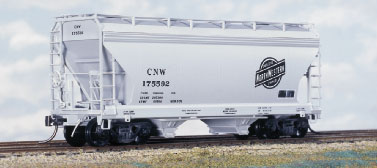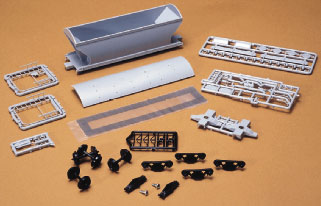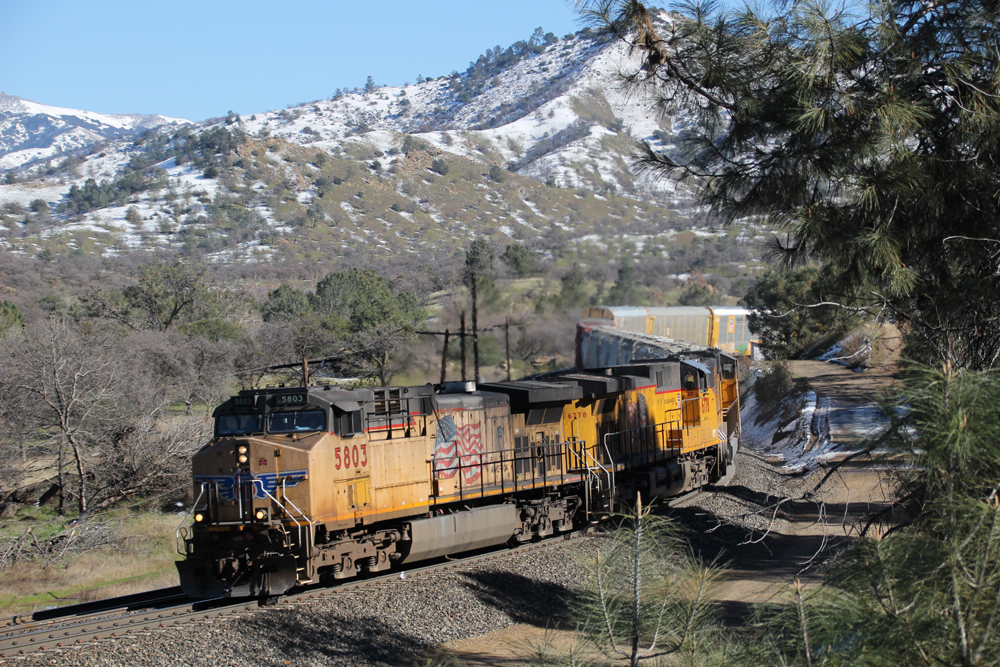American Car & Foundry’s Center Flow design dates back to the early 1960s, but these models represent 2,980-cubic-foot capacity cars built starting in 1973. They are differentiated from earlier Center Flow cars by having corrugated upper side plates, body-mounted brake cylinders (as opposed to truck-mounted ones on earlier cars), and sides made from six-foot-wide panels welded together.
Although two-bay Center Flow cars are short, they have the same 100-ton capacity as their longer cousins. They’re used primarily for hauling dense bulk products such as cement and sand.
The InterMountain kit features an injection-molded styrene body with detail parts that must be added. Separate pieces include the roof hatches, running-board supports, end ladder and framing, stirrup steps, roping staples, outlet gates, and brake gear, which includes the brake wheel, cylinder, reservoir, piping, and valve. The vast majority of these cars had 30″-diameter round roof hatches, but InterMountain includes trough hatches as well-a nice touch.
A highlight of the kit is the single-piece etched stainless steel running board. This provides a realistic thin cross-section and beautiful see-through effect, which is especially noticeable on covered hoppers since the running board takes up so much roof area. The running board is unpainted on undecorated cars and painted the appropriate color on decorated cars.
The kit went together well with no major difficulty. I used medium-viscosity cyanoacrylate adhesive (CA), applied with a toothpick, to attach most of the detail parts.
Be very careful in cutting the smaller plastic details from their sprues. I managed to break one of the air lines, and one of the running-board grab irons was already broken on the sprue. I was able to glue both back together as I installed them on the car.
The only alteration to the directions I recommend is to glue the stirrup steps and air hoses in place last (or just before adding the grab irons to the running board). These parts are in vulnerable positions and tend to get knocked around if applied too early in the assembly process. Dimensions of the finished model are dead-on compared to ACF drawings of this car.
Couplers aren’t included, so I added Kadee no. 5 couplers, which fit nicely in the car’s draft-gear boxes. Other automatic knuckle couplers would work as well. The draft-gear-box covers are held in place with friction pins, which don’t hold securely. I’d suggest placing a bit of glue on the pin before adding it, or – even better – drilling out the cover and box for a mounting screw. The couplers matched a Kadee height gauge.
The five-piece roller-bearing truck assemblies, made from acetal plastic, snap together easily. The single-piece scale 36″ wheelsets, also made from acetal plastic, were all a bit wide in gauge compared to a National Model Railroad Association standards gauge. Not much can be done to correct this, but I don’t think they’re off enough to affect operation. The car rolls quite freely.
Weights aren’t included, so I added 1.5 ounces of A-Line’s peel-and-stick lead weights to the car interior to bring the car to the NMRA recommended weight of 3.5 ounces. Keep any additional weight low, and keep it away from the round openings at the ends.
Our Chicago & North Western sample was neatly painted, and the paint scheme is accurate for that car; however, some of the data lettering was a bit fuzzy.
This is a very nice model of a common modern prototype.
Prices: undecorated $13.95; decorated $17.95
Manufacturer:
InterMountain Railway Co.
P.O. Box 839 Longmont, CO 80502-0839
www.intermountain-railway.com
Description:
Injection-molded styrene kit
Road names:
Chicago & North Western
Missouri-Kansas-Texas
Norfolk & Western
undecorated

















